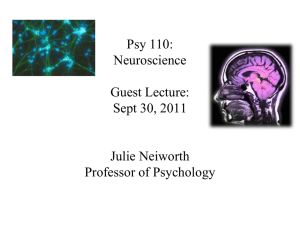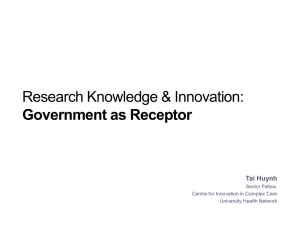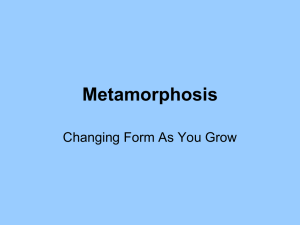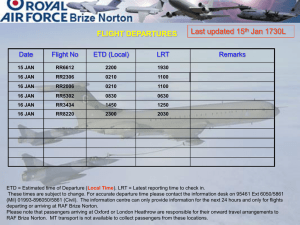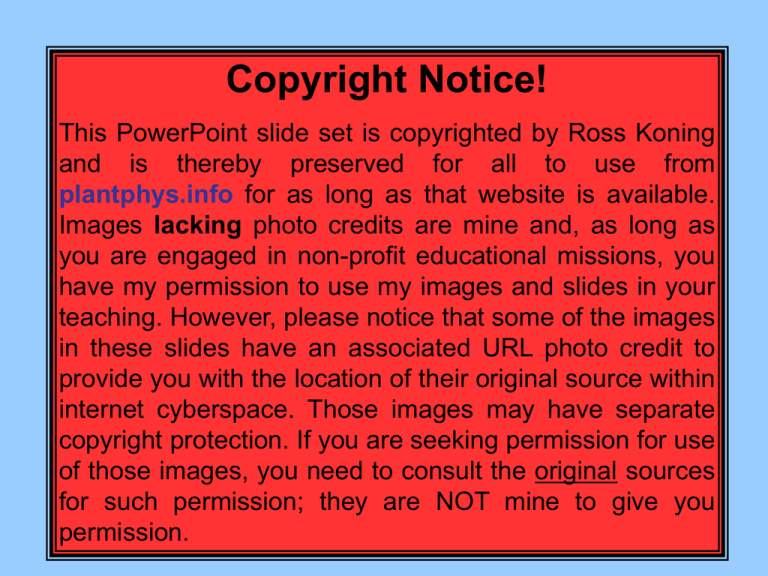
Copyright Notice!
This PowerPoint slide set is copyrighted by Ross Koning
and is thereby preserved for all to use from
plantphys.info for as long as that website is available.
Images lacking photo credits are mine and, as long as
you are engaged in non-profit educational missions, you
have my permission to use my images and slides in your
teaching. However, please notice that some of the images
in these slides have an associated URL photo credit to
provide you with the location of their original source within
internet cyberspace. Those images may have separate
copyright protection. If you are seeking permission for use
of those images, you need to consult the original sources
for such permission; they are NOT mine to give you
permission.
Biology:
life study of
What is Life?
Properties of Life
Cellular Structure: the unit of life, one or many
Metabolism: photosynthesis, respiration, fermentation,
digestion, gas exchange, secretion, excretion,
circulation--processing materials and energy
Growth: cell enlargement, cell number
Movement: intracellular, movement, locomotion
Reproduction: avoid extinction at death
Behavior: short term response to stimuli
Evolution: long term adaptation
http://www.casarioblanco.com/poison-dart-frog.jpg
http://aichlee.files.wordpress.com/2009/02/blue-bird-of-paradise.jpg
Obtaining Food
Heterotrophs need to
feed on other organisms, their byproducts, or their dead bodies to survive
Heterotrophic Organisms
Herbivores: feed directly upon producers
Carnivores: feed directly upon herbivores or other carnivores
Omnivores: feed upon both producers and consumers
Parasites: feed upon living organisms causing disease
Saprobes: feed upon by-products and/or dead bodies aka detritivore
Food is required as fuel for respiration:
Cytosolic Glycolysis:
sugars to pyruvate
Mitochondrial Matrix Krebs Cycle:
pyruvate to CO2 and NADH
Mitochondrial Cristae ETS/Oxidative Phosphorylation:
NADH and O2 to H2O and ADP + Pi to ATP
The feeding of Paramecium itself is internal digestion:
oral groove (alveolus)
cytopharynx
(mouth)
cilia movement
capture
contractile
vacuole
waste
endocytosis
elimination
(phagocytosis)
exocytosis
(anal pore)
food
vacuole
contractile
vacuole
enzymatic
digestion
subunit
absorption
micronucleus
macronucleus
Intracellular food digestion:
Golgi
lysosome
enzymes
endoplasmic
reticulum
subunits
waste
exocytosis
phagocytosis
food vacuole
1.
2.
3.
4.
5.
6.
digestive vacuole
phagocytosis of food
food vacuole formation
lysosome + food vacuole = digestive vacuole
enzymatic digestion of food
absorption of subunits
exocytosis of waste
©1996 Norton Presentation Maker, W. W. Norton & Company
Earthworms also have a tubular digestive system
Earthworms also have a tubular digestive system
subunit
uptake
enzymatic
digestion
intake
muscular grinding
©1996 Norton Presentation Maker, W. W. Norton & Company
waste
elimination
A look inside the digestive system:
• Mandibles chop food sideways
• Stomach holds food, grinds food
• Digestive gland injects enzymes
• Intestine absorbs subunits
• Rectum dehydrates wastes
• Anus ejects fecal pellet
http://www.life.umd.edu/entm/shultzlab/snodgrass/Lecture1/Figure1-8.gif
http://www.anselm.edu/homepage/jpitocch/genbios/33-33-InsectAnatomy-L.gif
She has a diverticulum to hold
the blood meal for later use.
She lives for 4-5 days on this
one blood meal.
The blood protein is used for
laying a “raft” of eggs in water.
piercing stylet
This female mosquito has sensory
organs to locate the victim animal
(thermal, CO2) and it’s blood
vessels (octenol).
She also has a stylet to pierce into
an animal’s circulation system.
©1996 Norton Presentation Maker, W. W. Norton & Company
http://www.cynical-c.com/archives/bloggraphics/aedes.jpg
Most birds
have a crop
for holding
food to feed
offspring.
The gizzard
assists in
mechanical
grinding of
food.
The intestine
does:
•enzymatic
digestion
•subunit
uptake
esophagus
intestine gizzard stomach
crop
rectum
cloaca
http://i.pbase.com/u49/wangi/upload/40767363.P1150275small.jpg
The rectum holds and partially dehydrates waste
The cloaca is a single passage area for:
digestive, urinary, and reproductive systems
In most vertebrates, digestion begins with mastication using teeth
connective
tissue
bone
Infection of
the gums
(periodontitis)
is associated
with
endocarditis!
In humans, tools (knives, blender, cooking pots) are used
to initiate food preparation externally!
©1996 Norton Presentation Maker, W. W. Norton & Company
Human Molar l.s.
Dentition may include cutting, tearing, and grinding teeth
cutting
grinding
Juvenile teeth may be
replaced by adult teeth
Human dentition indicates we are omnivores!
©1996 Norton Presentation Maker, W. W. Norton & Company
tearing
Among vertebrates the dentition has functional significance:
beaver
Huge indeterminate incisors
slash into young tree trunks,
molars grind plant material
deer
muscular lips tear off leaves,
molars grind them
dog
©1996 Norton Presentation Maker, W. W. Norton & Company
snake
grasping and angled
back for swallowing
prey whole
large canine teeth and
pointed molars (more like
canines), designed for
tearing animal flesh…minimal
grinding of tissue
Not shown:
ventilation system
connects at glottis in
throat (pharynx)
amylase
peristalsis
©1996 Norton Presentation Maker, W. W. Norton & Company
The human digestive system:
©1996 Norton Presentation Maker, W. W. Norton & Company
The movement of food in the digestive tube is by peristalsis
amylase
acidic
portion
bile (emulsifier)
bacterial culture
unknown
pepsin, HCl
trypsin, amylase,
H2CO3 (alk),
lipase
water reabsorption
subunit absorption
waste holding,
elimination
alkaline
portion
©1996 Norton Presentation Maker, W. W. Norton & Company
The human digestive system:
circular
muscles
for
peristalsis
©1996 Norton Presentation Maker, W. W. Norton & Company
An intestinal cross section reveals the increased surface area:
villi
©1996 Norton Presentation Maker, W. W. Norton & Company
To increase the surface area of the absorptive regions of
the intestine, the lining is corrugated and lined with villi
sugars,
amino acids,
nucleotides
Notice how the villus is coated with microvilli…for more area!
©1996 Norton Presentation Maker, W. W. Norton & Company
The villi of the intestine have good blood supply for nutrient uptake
microvilli
villus
©1996 Norton Presentation Maker, W. W. Norton & Company
Here you can see the microvilli from a single villus
Digestion of polysaccharides
amylase
glu
Starch
amylase
glu
Glucose Glucose
-1,4 glycosidic bond
glu
amylase
glu
Maltose
maltase
glu
glu
Maltose
maltase
Glucose Glucose Glucose Glucose Glucose Glucose
These monosaccharides are ready for
absorption from the digestive system.
Proteins are polymers of some 22 different amino acids
Enzymes cleave the peptide bond during…
Protein digestion in mammals:
Stomach
pepsin
amino end His
Glu
Tyr
pepsin
recognize phenolic AA, cleave amino side
Thr
Lys
His
Glu
Ser
Arg
Asp
Trp
Thr
Phe
carboxyl end
recognize phenolic AA, cleave carboxyl side
Pancreas
chymotrypsin trypsin recognize basic AA, trypsin
chymotrypsin
cleave carboxyl side
His
Glu
Tyr
Thr
Lys
His
Glu
Ser
Arg
Asp
Trp
Thr
Phe
Thr
Phe
cleave AA from amino end cleave AA from carboxyl end
terminal AA removers
His
Glu
aminopeptidase carboxypeptidase
Tyr
Thr
Lys
His
Glu
Ser
Arg
Asp
Trp
dipeptide splitter
recognize dipeptide, cleave peptide bond
dipeptidase
dipeptidase
dipeptidase
dipeptidase
His
Glu
Tyr
Thr
Lys
His
Glu
Ser
Arg
Asp
Trp
Thr
Phe
His
Glu
Tyr
Thr
Lys
His
Glu
Ser
Arg
Asp
Trp
Thr
Phe
Individual Amino Acids For Absorption in Small Intestine
How do you make digestive enzymes without digesting yourself?
Chymotrypsinogen conversion into chymotrypsin
Finished chymotrypsin
with active site
Activation by acidic recognizing Tyr, Trp
and Phe
pepsin cleavage
©1996 Norton Presentation Maker, W. W. Norton & Company
Chymotrypsinogen from
pancreas is inactive
Summary of macromolecule digestion into subunits
Polysaccharides
Disaccharides
Monosaccharides
starch
(amylose)
salivary amylase
pancreatic amylase
Proteins
maltose
sucrose
lactose
Peptides
Endopeptidases:
stomach pepsin
pancreatic trypsin
pancreatic chymotrypsin
intestinal
maltase
sucrase
lactase
gluose
frucose
galactose
Amino Acids
Exopeptidases:
pancreatic
intestinal
monoglycerides
Fats (triglycerides)
Emulsified fats pancreatic lipase fatty acids
liver bile
glycerol


